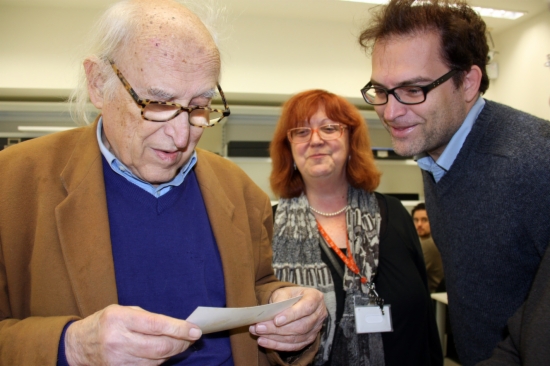Oriol Maspons, the photographer who depicted life in Barcelona between the 1950s and 1980s, dies aged 84
Maspons was one of the greatest Catalan photographers of all time. He is famous for his pictures of the former Somorrostro slum in the Barceloneta beach, party life in Ibiza during the 1970s and Barcelona’s left-wing group of bourgeois intellectuals from the 1970s, known as ‘Gauche Divine’. Maspons worked mostly in Catalonia, but also in Paris and the States. In fact, New York’s Museum of Modern Art (MoMA) exhibits pictures taken by Oriol Maspons. He received top honours in Catalonia, such as the Catalan Government’s Sant Jordi Cross and Barcelona City’s Gold Medal. In 2010, he donated his private collection of some 5,500 pictures to Catalonia’s National Museum of Art (MNAC), which will organise a “large exhibition” on his work.

Barcelona (ACN).- Oriol Maspons, one of the greatest Catalan photographers of all time, died in Barcelona on Monday morning aged 84. Maspons, who has some of his work on show at New York’s Museum of Modern Art (MoMA), was mainly famous for his pictures of the former Somorrostro slum in the Barceloneta beach during the 1960s, early party life in Ibiza during the 1970s and Barcelona’s left-wing bourgeois intellectual group from the 1960s and 1970s, known as ‘Gauche Divine’. Maspons worked mostly in Catalonia, but also in Paris and in the US. He illustrated the book ‘Poet in New York’ by Federico García Lorca as well as many books about Barcelona, notably one with his colleague Xavier Miserachs. Maspons received top honours in Catalonia, such as the Catalan Government’s Sant Jordi Cross (2006) and Barcelona City’s Gold Medal (1998). In 2010, he donated his private collection of some 5,500 pictures to Catalonia’s National Museum of Art (MNAC), which will organise “a large exhibition” on his work. The Catalan Minister for Culture, Ferran Mascarell, defined Maspons as “an activist of modernity” and “one of the greatest creators” in Catalonia. The Mayor of Barcelona, Xavier Trias, stated that the Catalan photographer “had portrayed the many faces of Barcelona”, “from the Somorrostro” shanty town to “the characters of the Gauche Divine”. The photography curator-in-chief of the MNAC, David Balsells, compared Maspons’ avant-garde work to that of “the greatest American photographers”. He will be buried in Greater Barcelona’s town of l’Ametlla del Vallès.
One of the big names of Catalonia’s cultural landscape died today. Oriol Maspons was probably the greatest Catalan photographer alive, recognised as a master by current prominent photographers, having influenced the generations after him. Oriol Maspons, born in Barcelona in 1928 into a bourgeois family, moved to Paris in 1955 due to his work in an insurance company. From there, he started to publish pictures on Paris Match, Elle and Bocaccio. On his return to Barcelona in 1957, he started to work as a professional photographer and soon became one of the most important artists portraying the post-war society of the 1950s and the 1960s.
Depicting all the sides of Barcelona
With his camera he captured iconic images of Barcelona’s poor downtown neighbourhoods, such as the Raval or the shanty towns built near the port, such as Somorrostro, which was a slum literally located on today’s Barceloneta beach. However, Maspons also took photographs of the early economic development of the 1960s and 1970s, and particularly, of the bohemian and party life of that time. Furthermore, he devoted most of his work to picture the group of left-wing Barcelona intellectuals born just after the Spanish Civil War, most of them from privileged bourgeois families, which were known as the ‘Gauche Divine’. In addition, he also portrayed the early developments of bohemian and party life in Ibiza in the 1970s.
Maspons, who had a great sense of humour, stated that his profession “had been a privilege”, “which is now over”, due to the technological change and the time-pressure. “We were cultivated photographers, I am not ashamed to recognise it”, he told CNA in 2011; “we were educated because the practice of our job had given it us”.
A master of masters
He is often included in the artistic movement of the so-called Barcelona School of the 1950s and 1960s, which included poets, writers, photographers and film-makers. Maspons worked with other photographers, such as Xavier Miserachs – with whom he published a book on Barcelona – as well as Leopoldo Pomés and Colita. He was considered to be a master by the current top photographers in Catalonia.
Maspons donated his work to the MNAC
By the end of 2010 he announced that his personal archive would stay in Catalonia. He was concerned about the destination of his work, after having seen material of famous photographers being sold on some flea markets or cheap auctions. He took the decision to donate all his archive to the MNAC, with the Elsa Peretti Foundation acting as sponsor having the responsibility to classify, index and restore the works. Initially it was thought the fund would be of some 1,500 images, but finally around 5,500 were found. The MNAC has already announced it is preparing “an ambitious project on Maspons’ work, with “a large exhibition” and the publication of a book.